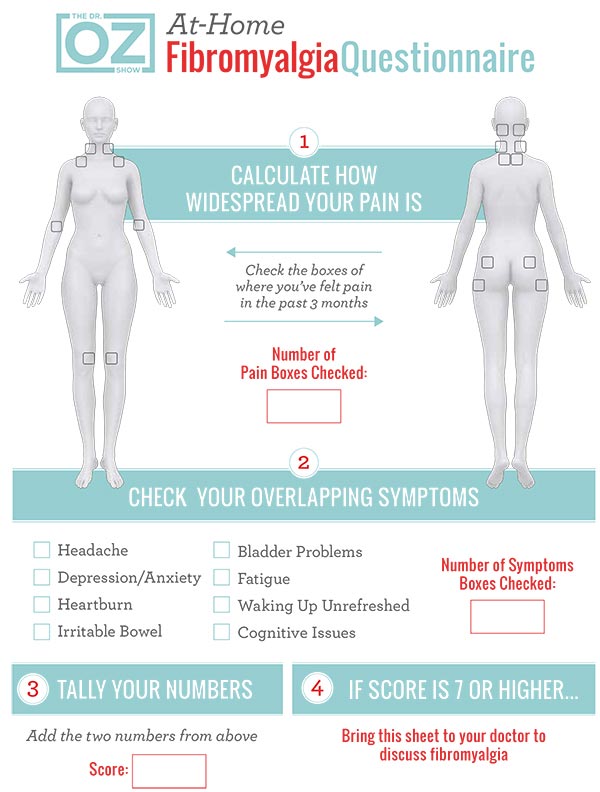Can you take a test on your own to diagnose fibromyalgia at home? That is one of the most common questions asked when individuals suspect they may have fibromyalgia.
The short answer is yes; there are ways to evaluate whether or not your symptoms could be related to fibromyalgia.
The long answer is not really. The only way to obtain an accurate diagnosis of fibromyalgia is to see a doctor, maybe even a specialist.
1- Fibromyalgia Is Not the Latest Fashion Trend
If you are familiar with the website www.thefibrowarriors.com, you know that I am a big proponent of diagnosing fibromyalgia by visiting a healthcare professional.
Talking about a Home test to self-diagnose fibromyalgia may sound like a contradiction. I am not following my core philosophy of trusting my medical provider.
The following is only a way to understand better whether or not you have symptoms that could be associated with fibromyalgia.
The final diagnosis should always be sanctioned by your doctor, nurse practitioner, physician’s assistant, GP, or the like. Fibromyalgia is a severe condition, one that is often misunderstood.
Fibromyalgia is not the way to go if you’re looking for attention. You will more likely be met by skepticism and snark than pity and positive attention.
Fibromyalgia is not a joke and does not accessorize very well in socialites circles.
2- So, Is There a Home Test?
Some guidelines were established by prominent professors and doctors specializing in fibromyalgia research. It is called the Fibromyalgia Impact Questionnaire.
It is a series of 21 questions that allow you to look at your daily life to see what may be made more noticeable by fibromyalgia.
It asks about the difficulty level you experience during what most Personal Care Assistant agencies call Activities of Daily Loving. It is rated on a 1 to 10 scale.
The second part of the questionnaire focuses on the sensory aspect of fibromyalgia. In other words, it looks at what bothers you and what makes your daily life a living hell.
While the Fibromyalgia Impact Questionnaire (FIQ for short) is a good, basic test, it remains a questionnaire established in the 1980s. It was made available to the public in 1991. That was 26 years ago, my friends.
It’s hardly relevant to today’s real world! Drs Burckhardt, Clark, and Bennett gave us an incredible tool for 1991, but its relevance today is questionable.
They did come up with a revised version which is today in use. They called it the Fibromyalgia Impact Questionnaire-Revised or FIQR.
My issue with the questionnaire is not that it’s the wrong tool. I mean, they certainly worked hard to make it as concise as possible so that most patients could follow along and understand it.
That’s great. But the problem with concision is that it tends to paint things with a broad brush. You don’t get into the details. If by chance you have atypical symptoms, relying on restrictive material could make you miss the issue entirely.
That is why I always encourage people to check with their doctor. Because what if you’re not including this or that symptom recorded in your medical chart because, to your untrained eye, it has no connection with fibromyalgia?
3- Whoa. Is a Home Tool to Diagnose Fibromyalgia That Bad?
Of course not! Please don’t read too much into my words! That is way too dangerous and aleatory! To clarify, I would always encourage you to see a medical professional. The internet cannot be your only source of medical advice.
But that does not mean that a test you can take in the comfort of your home, away from judgemental looks, has no merit. It would be best if you looked into a symptom checker.
There are good uses for home diagnosing tests. But, the best reason for them to opt for an in-home test is to determine whether or not they should approach their doctor with fibromyalgia in mind.
Rheumatology.org tells us that the FIQR has been widely used “as an index of disease activity and therapeutic efficacy.” The FIQ is used to gauge the influence of symptoms in a patient’s life.
Despite the questionnaire’s archaic and sometimes arcane nature, physicians often refer to the FIQ to better understand Fibro Warriors’ pain and daily suffering.
4- Ok, So It’s Bad but Not That Bad
That pretty much sums it up.
The problem with a home test is the lack of control over the variables. Any reputable research facility will tell you that strict guidelines must be followed. Your efforts cannot just be in good faith.
The FIQ and, subsequently, the FIQR are tools for measuring abstract and subjective data. On a scale of 1 to 10, my level 3 pain may be your level 8 pain.
Take my daughter, for example, who was stepped on by a horse – that’s a story for another time! – and she lost part of her spleen in the accident.
Along with a loss of one-third of her spleen, she suffered multiple internal injuries requiring a stay in the ICU. She was in so much pain that her body shot down.
She lost consciousness periodically for the better part of 24 hours. She has what is called a vagal syncope. Yes, it was as scary as it sounds.
Anyhow, let me get to the point. A couple of months ago, she started having difficulties moving her arm. It was a mechanical issue, if you will.
I took her to the doctor’s, wondering what was going on. When they asked her how bad the pain was, she said it was maybe a 4. Maybe. But more like a 3. And mostly when the doctor pushed on it. The doc told us it was nothing but a sprain. I insisted on getting an X-ray, knowing my kid and her superhuman pain tolerance.
Sure enough, she had broken her arm.
In three spots.
Two days before I took her in.
Mine walked around for two days with a broken arm, only noticing when it became difficult to move it physically. The doctors were baffled. I was told that a kid with a break this bad would usually be rolling on the floor screaming.
So yes, her pain tolerance is not my pain tolerance. On a 1 to 10 scale, her three is my 11…
That is all to say that a subjective pain scale, or difficulty scale, is unreliable. I would argue that if you get a ten on every single question, you may have fibromyalgia.
The issue is when you score a two or a three on everything simply because you’re a tough cookie and push through the pain to get your day moving. What then?
The home test tells you that you have zero symptoms of fibromyalgia. You’re as healthy as it comes. You barely hurt at all. That’s all fine and dandy, but the accuracy is flawed.
5- What’s the Harm?!?
For people who exhibit symptoms that are book-perfect, I guess there is no harm.
But how many Fibro Warriors do you know who have “perfect” symptoms? I bet you can count them on one hand. I know I don’t know any. And I spend my days researching fibromyalgia!
The Harm lies with those who exhibit atypical symptoms. It lies with those looking for answers but unsure how to use the test.
It lies with the person who is desperate to understand what is going on with their body, and as they look for validation on the internet, they are met with a “test” that confirms they have nothing wrong at all.
The Harm lies with the person who feels it’s all in his head since he passed the checklist test with flying colors.
6- Drumroll, Please… Here Come the Questions!
I know it seems like I do not hold much faith in the questionnaires devised to self-diagnose fibromyalgia from the comfort of your living room. But the cat is out of the bag. The questions are out there.
Only so many versions of the essential questions can be asked. Once you have narrowed down the primary symptoms of the “typical” fibromyalgia patient (HA! Like there is such a thing…), the wording may differ slightly, but the core of the matter remains the same.
So here are two examples of questionnaires you can use as a tool to talk to your doctor.
The first one was designed by Doctor Oz – a well-known American television doctor.

This straightforward tool is not elaborate and very easy to understand. I consider this a good starting point in your journey to a fibromyalgia diagnosis.
The second tool has been designed by the Portland-based Oregon Health and Science University research team led by Dr. Burckhardt, Dr. Bennett, and Dr. Clark.
It has been the long-standing standard for fibromyalgia, to which I referred earlier in this article as the FIQR – Fibromyalgia Impact Questionnaire-Revised. It is featured on the website www.rheumatology.org.
For more on the following information concerning the FIQR, you can go to www.fiqr.info.
The website www.fiqr.info tells us the instructions to fill out the questionnaire are as follows:
“The FIQR is made up of 3 domains; functional (9 questions), overall (2 questions), and symptoms (9 questions). Here are the instructions given to subjects for answering each of the three domains, along with the 21 questions that make up the FIQR:
Functional domain: For the following nine questions, check the box that best indicates how much your fibromyalgia made it challenging to perform the following activities during the past seven days.
If you did not perform a particular activity in the last seven days, rate the difficulty of the last time you performed the activity. If you can’t perform an activity, check the last box.
- Brush or comb your hair.
- Walk continuously for 20 minutes.
- Prepare a homemade meal.
- Vacuum, scrub, or sweep floors
- Lift and carry a bag full of groceries
- Climb one flight of stairs
- Change bed sheets
- Sit in a chair for 45 minutes
- Go shopping for groceries
Overall domain: For each of the following two questions, check the box that best describes the overall impact of your fibromyalgia over the last seven days:
- Fibromyalgia prevented me from accomplishing goals for the week
- I was completely overwhelmed by my fibromyalgia symptoms
Directions: For each of the following ten questions, select the box that best indicates your intensity of these common fibromyalgia symptoms over the past seven days:
- Please rate your level of pain
- Please rate your level of energy
- Please rate your level of stiffness
- Please rate the quality of your sleep
- Please rate your level of depression
- Please rate your level of memory problems
- Please rate your level of anxiety
- Please rate your level of tenderness to touch
- Please rate your level of balance problems
- Please rate your level of sensitivity to loud noises, bright lights, odors, and cold
The SIQR (symptom impact questionnaire), which is used for patients with diagnoses other than fibromyalgia, is precisely the same as the FIQR but omits the word “fibromyalgia” in the questions.”
7- Any Final Thoughts?
I find it unsettling to know that there is a home test out there that will influence whether or not someone believes they have fibromyalgia, but also whether or not that person seeks medical advice for the symptoms they are experiencing.
See, the thing is, if you are taking the time to research a fibromyalgia diagnosing questionnaire at home, chances are you are experiencing symptoms that are bad enough that make you think you have some medical issue that needs to be addressed. Whether it is fibromyalgia or not, ultimately that, does not matter.
Fibromyalgia may not be your final diagnosis. What matters is that you no longer have to live with symptoms that bother you. No one should live in pain.
You may have different or other conditions on top of your fibromyalgia. The important thing is to consult a healthcare professional to have clear answers.
I have debated over posting or not posting a copy of those self-diagnosing tools for a good while. I thought that posting them would go against my philosophical views regarding this type of questionnaire.
But then I realized that all of this is bigger than my views. I tend to lose sight of the higher goal, which is having symptom-free and happy people, regardless of how they reach that goal. Seriously, it’s none of my business. This is not why I write these articles.
I write them so others know they are not alone, so we can all find solutions to our chronic pain issues, fibromyalgia or not.
In the end, if it can help someone engage in a dialogue with their healthcare professional, it is absolutely worth it.
I remember how difficult it was for me to approach my family doctor about my symptoms. I did not know how to explain what I was feeling. I could not find the right words to convey how miserable I was.
In addition, the questionnaires may even help you realize that some of the pains, aches, issues, and feelings you experience could be abnormal.
After all, as Fibro Warriors, we tend to repress our pain, and after a while, it just becomes our new normal. So if reading about a symptom makes you see that it is not supposed to be “normal,” then it is worth it.
So go ahead, Fellow Fibro Warriors! Answer the questions and bring your answers as a starting point for an all-important discussion about your healthcare. You deserve it! And keep up the good fight!
Thanks for reading this article! Let me disclose that I am not a doctor or a healthcare professional in any way, shape, or form. The articles I write tell my story. I want to share with others what it is like to have fibromyalgia, with the ups and downs that come with it. I am not one to sugarcoat things, so that you can expect blunt honesty from me. My goal is to relate real stories, feelings, and physical sensations. It may not be “politically correct” at times, but it reflects my personal experiences.

 Melinda Miles is a courageous fibromyalgia warrior living with the condition for over 10 years. She is an advocate and voice in the fibromyalgia community, having created an online blog, TheFibrowarriors.com, to provide education, support, and community for those affected by this often misunderstood condition.
Melinda Miles is a courageous fibromyalgia warrior living with the condition for over 10 years. She is an advocate and voice in the fibromyalgia community, having created an online blog, TheFibrowarriors.com, to provide education, support, and community for those affected by this often misunderstood condition.